#multiflora rose growing through the window
Explore tagged Tumblr posts
Text

Broken Window, NJ - May 26th 2024
#nature#destroyed and abandoned#photographers on tumblr#original photography#multiflora rose growing through the window#njlocal#spring#portal
14 notes
·
View notes
Text
Meet the Ecologist Who Wants You to Unleash the Wild on Your Backyard
https://sciencespies.com/nature/meet-the-ecologist-who-wants-you-to-unleash-the-wild-on-your-backyard/
Meet the Ecologist Who Wants You to Unleash the Wild on Your Backyard
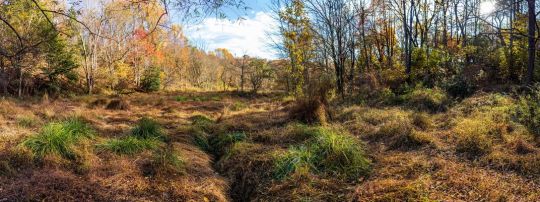
The land is ten gently sloping acres in rural southeastern Pennsylvania, at one time mowed for hay, with a handsome farmhouse that Douglas Tallamy bought around 20 years ago. It isn’t much to look at, by the standards most Americans apply to landscaping—no expansive views across swaths of lawn set off by flowerbeds and specimen trees—but, as Tallamy says, “We’re tucked away here where no one can see us, so we can do pretty much what we want.” And what he wants is for this property to be a model for the rest of the country, by which he means suburbs, exurbs, uninhabited woods, highway margins, city parks, streets and backyards, even rooftops and window boxes, basically every square foot of land not paved or farmed. He wants to see it replanted with native North American flora, supporting a healthy array of native North American butterflies, moths and other arthropods, providing food for a robust population of songbirds, small mammals and reptiles. He even has a name for it: Homegrown National Park.

A creek on his land supports native plants adapted to “getting their feet wet,” Tallamy says, such as skunk cabbage.
(Matthew Cicanese)
On a June day in 2001, not long after he bought the property, Tallamy, an entomologist at the University of Delaware, was walking his land when he noticed something that struck him as unusual. Before he bought it, most of it had been kept in hay, but at that point it hadn’t been mowed in three years and “was overgrown with autumn olive and Oriental bittersweet in a tangle so thick you couldn’t walk. The first thing I had to do was cut trails,” Tallamy recalls. And walking through his woods on the newly cut trails, what he noticed was what was missing: caterpillars.
No caterpillars on the Oriental bittersweet, the multiflora rose, the Japanese honeysuckle, on the burning bush that lined his neighbor’s driveway. All around him plants were in a riot of photosynthesis, converting the energy of sunlight into sugars and proteins and fats that were going uneaten. A loss, and not just for him as a professional entomologist. Insects—“the little things that run the world,” as the naturalist E.O. Wilson called them—are at the heart of the food web, the main way nature converts plant protoplasm into animal life. If Tallamy were a chickadee—a bird whose nestlings may consume between 6,000 and 9,000 caterpillars before they fledge, all foraged within a 150-foot radius of the nest—he would have found it hard going in these woods.
Tallamy knew, in a general sense, why that was. The plants he was walking among were mostly introduced exotics, brought to America either accidentally in cargo or intentionally for landscaping or crops. Then they escaped into the wild, outcompeting their native counterparts, meeting the definition of an “invasive” species. By and large, plants can tolerate a wide range of environmental conditions. But insects tend to be specialists, feeding on and pollinating a narrow spectrum of plant life, sometimes just a single species. “Ninety percent of the insects that eat plants can develop and reproduce only on the plants with which they share an evolutionary history,” Tallamy says. In the competition to eat, and to avoid being eaten, plants have developed various chemical and morphological defenses—toxins, sticky sap, rough bark, waxy cuticles—and insects have evolved ways to get around them. But as a rule, insect strategies don’t work well against species they have never encountered. That’s true of even closely related species—imported Norway maples versus native sugar maples, for instance. Tallamy has found that within the same genus, introduced plant species provide on average 68 percent less food for insects than natives. Hence, a plant that in its native habitat might support dozens or hundreds of species of insects, birds and mammals may go virtually uneaten in a new ecosystem. Pennsylvania, for example.
Demonstrating that point might make for a good undergraduate research project, Tallamy thought. So he asked a student to do a survey of the literature in preparation for a study. The student reported back there wasn’t any. “I checked myself,” he says. “There was a lot written about invasive species. But nothing on insects and the food web.”
That, he says, was the “aha” moment in his career, at which he began to remake himself from a specialist in the mating habits of the cucumber beetle to a proselytizer for native plants as a way to preserve what remains of the natural ecology of North America. He was following in the footsteps of Wilson, his scientific hero, who went from being the world’s foremost expert on ants to an eminent spokesman for the ecology of the whole planet. “I didn’t exactly plan it this way,” Tallamy says with a shrug. “In the musical chairs of life, the music stopped and I sat down in the ‘invasive plants’ chair. It’s a satisfying way to close out my career.”
As a scientist, Tallamy realized his initial obligation was to prove his insight empirically. He began with the essential first step of any scientific undertaking, by applying for research grants, the first of which took until 2005 to materialize. Then followed five years of work by relays of students. “We had to plant the plants and then measure insect use over the next three years, at five different sites,” he recalls. “To sample a plot was an all-day affair with five people.” Out of that work eventually came papers in scientific journals such as Conservation Biology (“Ranking lepidopteran use of native versus introduced plants”), Biological Invasions (“Effects of non-native plants on the native insect community of Delaware”) and Environmental Entomology (“An evaluation of butterfly gardens for restoring habitat for the monarch butterfly”). And then popularizing books aimed at changing the face of America’s backyards: Bringing Nature Home: How You Can Sustain Wildlife With Native Plants and, this year, Nature’s Best Hope: A New Approach to Conservation That Starts in Your Yard. And in turn a busy schedule of talks before professional organizations, environmental groups, local conservation societies, landscape designers—anyone who would listen, basically.
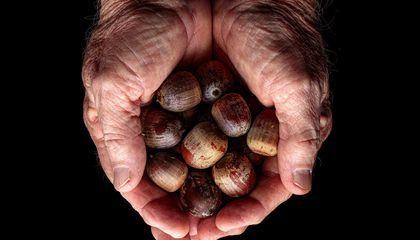
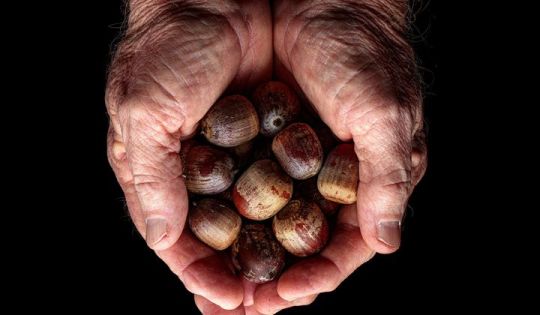
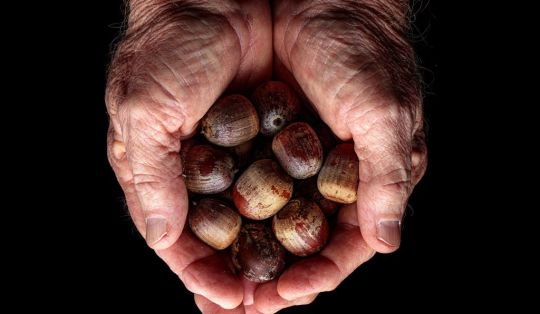

Squirrels aren’t the only animals that like acorns. Weevils develop inside the oaknuts, and the larvae, in turn, nourish blue jays and woodpeckers
(Matthew Cicanese)
When insects disappear, humans may not take much notice, but the recent population declines of two species have received a great deal of attention: the monarch butterfly, because it’s an iconic, easily recognizable and beautiful creature; and the honeybee, because it’s needed to pollinate crops. But those episodes are symptomatic of a larger disruption in the ecosystem. Tallamy estimates that the worldwide population of arthropods, chiefly insects, has declined by 45 percent from preindustrial times. Without insects, it would be the case that lizards, frogs and toads, birds and mammals, from rodents up through bears, would lose all or a large part of their diets. “The little things that run the world are disappearing,” he says. “This is an ecological crisis that we’re just starting to talk about.”
Tallamy is 68, graying, soft-spoken and diffident. In his talks he cloaks the urgency of his message with an understated wit, as when he presses the unpopular cause of poison ivy, whose berries at certain times of the year are an important food for the downy woodpecker and other birds. “When do you get a rash from poison ivy?” he asks an audience. “When you try to pull it out! Ignore your poison ivy. You can run faster than it can.” To which many people would reply: “Nature had plenty of poison ivy and insects in it the last time I was there.”
But to Tallamy, that attitude is precisely the problem. It speaks to a definition of “nature” as co-extensive with “wilderness,” and excludes the everyday landscape inhabited by virtually all Americans. The ecosystem cannot be sustained just by national parks and forests. A statistic he frequently cites is that 86 percent of the land east of the Mississippi is privately owned. A large fraction of that acreage is either under cultivation for food or planted in a monoculture of lawn, a landscape that for ecological purposes might as well be a parking lot.
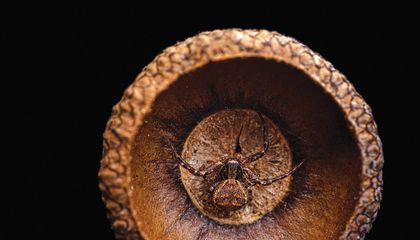
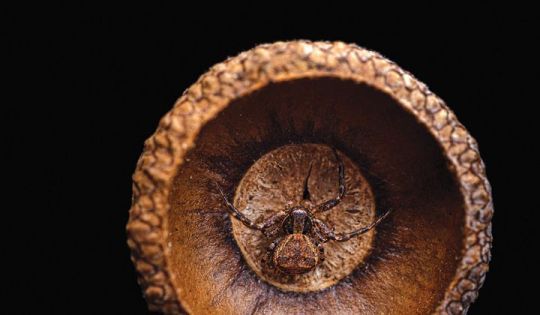
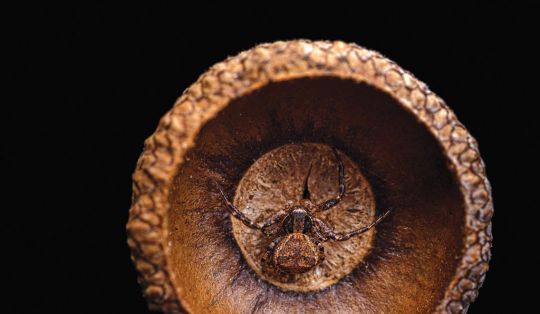

To Tallamy, spiders serve as a linchpin species to birds because they are the second most important food, outweighed in nutritive value only by caterpillars.
(Matthew Cicanese)
Tallamy incorporated his thinking into “Homegrown National Park,” an aspirational project to repurpose half of America’s lawnscape for ecologically productive use. That would comprise more than 20 million acres, the equivalent of nearly ten Yellowstones. The intention is to unite fragments of land scattered across the country into a network of habitat, which could be achieved, he wrote in Bringing Nature Home, “by untrained citizens with minimal expense and without any costly changes to infrastructure.” The plots wouldn’t have to be contiguous, although that would be preferable. Moths and birds can fly, and you’re helping them just by reducing the distance they have to travel for food.
“Every little bit helps,” Tallamy says. “Most people don’t own 50 acres, so it’s not going to be that hard. The minimal thing is, you plant a tree and it’s the right tree. Look at what’s happened at my house.”
The idea was picked up by the writer Richard Louv, who coined the term “nature-deficit disorder” in his jeremiad Last Child in the Woods, and by the Canadian naturalist and philanthropist David Suzuki, whose foundation is supporting an effort to implement the project on a limited scale in Toronto.
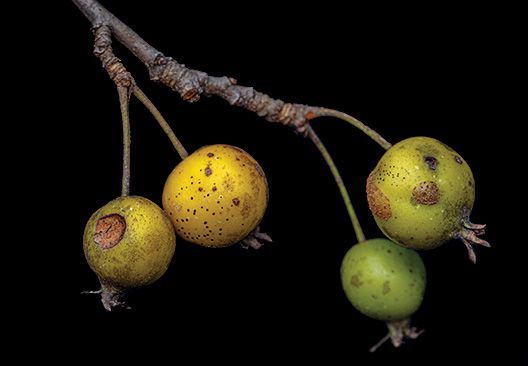
Even a small patch of Pennsylvania woodland, if allowed to grow wild, generates a vast ecosystem: Native crabapples persist into winter and feed foxes and wild turkeys.
(Matthew Cicanese)
Tallamy walks his land in all seasons, wrenching from the soil the occasional Japanese honeysuckle that made the mistake of venturing onto his property, checking up on his winterberries and sweet pepperbush, looking for leaves that have been chewed by insects and the stems of berries eaten by birds. Occasionally he will do a moth survey, hanging a white sheet in his woods at night behind a mercury vapor lamp. The diversity of insect life he encounters is eye-opening even to him; last year he added more than 100 species to his property list, including a few he had to look up to identify. (There are around 11,000 species of moths in the United States, and 160,000 worldwide.) Near his front door is a 35-foot-tall white oak that he planted from an acorn, ignoring the advice some landscapers give against planting oaks, because you won’t live long enough to enjoy them at their mature size, which may take 300 years. “Well, if you can only enjoy a 300-year-old oak, I guess that’s true,” he says dryly. He has collected 242 species of caterpillars from the tree in his yard—so far.
Tallamy is a great proponent of the ecological benefits of caterpillars, a single one of which has the nutritional value of as many as 200 aphids. “They’re soft, you can stuff them down the beak of your offspring without damaging their esophagus,” he says approvingly. “They contain carotenoids. Birds take the carotenoids and build pigments out of them. That’s how you make a prothonotary warbler.”
He acknowledges that not all homeowners enjoy the sight of caterpillars munching on the leaves of their trees. For them he recommends what he calls his Ten-Step Program: “Take ten steps back from the trunk and all your insect problems go away.”
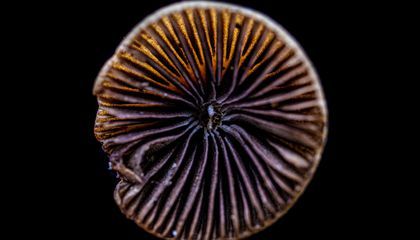
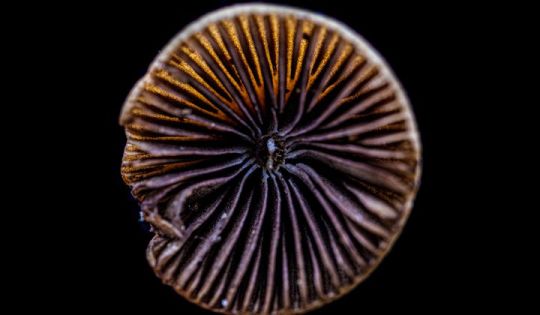
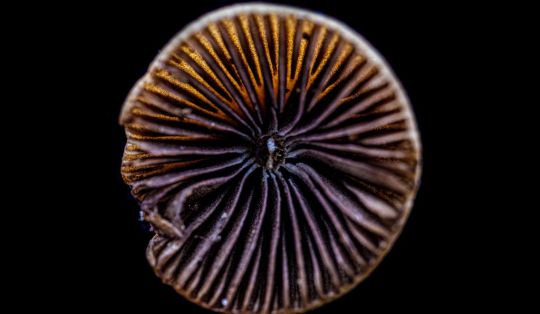

Mushrooms enrich the teeming soil when they decompose.
(Matthew Cicanese)
Tallamy’s principles have a particular resonance with people—like me—who consider themselves environmentalists but landscaped on the principle “if it looks good, plant it.” He says he’s sometimes surprised at how well his message is received. “I thought there would be quite a bit of push back,” he muses. “But there hasn’t been. I’m suggesting we cut the lawn area in half. I assume they just aren’t taking me seriously. Early on I remember a nurseryman in the audience glowering at me, and I heard him muttering ‘You’re trying to put us out of business.’ I don’t want to put them out of business. I get a lot of invitations from the nursery industry, trade shows, landscape architects. All I’m saying is add one criterion to what you use when you choose your plants”—whether a plant is native. “You can’t argue against it.”
Actually, you can. Tallamy has a long-standing scientific disagreement with an entomologist at the University of California at Davis, Arthur Shapiro. Shapiro grew up in Philadelphia, where, he says, the Norway maple on his block in the 1960s was host to at least three species of moth caterpillar: the American dagger moth, the Crecopia silk moth,and the Lunate Zale moth. “Tallamy invokes the diversity of caterpillars as an indicator of the superiority of native plants over nonnative plants,” Shapiro says. “It’s unsurprising that most of them feed on native plants. What goes right by Tallamy is the extent to which native insects switch and adapt to nonnative plants.
“Here in California we are probably more heavily impacted by naturalized plants than any other state except Hawaii. Our low-elevation butterflies are heavily dependent on nonnative plants. Their native host plants have been largely eradicated, but to their good fortune, humans introduced nonnative plants that are not only acceptable but in some instances superior to native hosts. Most California natives in cultivation are of no more butterfly interest than nonnatives, and most of the best butterfly flowers in our area are exotic.”
The much-reviled (but also beloved by some) eucalyptus trees that have colonized the Central California coast now harbor overwintering monarch butterflies, Shapiro says, although for the most part the insect populations they support are different from those found in native habitats. But his attitude is, so what? The marine blue, a butterfly native to the desert Southwest, where it feeds on acacia and mesquite, has expanded its range into the suburbs of Southern California, feeding on leadwort, a perennial flowering shrub native to South Africa. It is botanically unrelated to acacia and mesquite, but by some accident of biochemistry is a suitable host for the marine blue caterpillar, which has adapted to its new host. “That sort of process is happening all the time all around us,” Shapiro says.
Tallamy begs to differ. The examples Shapiro cites, in his view, represent either anecdotal findings of limited scientific value (like the caterpillars on the street tree from Shapiro’s childhood), or anomalous exceptions to the rule that introduced species support a fraction of the insect life of the plants they replace. A ginkgo tree might look like a functional part of an ecosystem, but the Chinese native might as well be a statue for all the good it does. The well-publicized instances of alien species that found American vegetation to their taste—Asian long-horned beetles, European corn borers, gypsy moths—have created the misleading impression that to an insect, one tree is as good as another. But those are exceptional cases, Tallamy maintains, and the great majority of insects accidentally introduced to North America are never heard from again. “Remember, the horticulture trade screens plants before they introduce them into the market. Any plant that is vulnerable to serious attack by native insects is screened out.”
On one level, this dispute reflects that Tallamy and Shapiro have studied very different ecosystems. As Tallamy wrote in Bringing Nature Home, he was “forced to slight western North America and focus on the Lepidoptera that occur on woody plants in eight states of the eastern deciduous forest biome.” The scientists’ disagreement is also partly over time scales. Tallamy acknowledges that natural selection will allow some native insects to evolve the ability to eat whatever is growing in front of them, or be replaced by species that can, and that birds will figure out a way to make a living off the newcomers. But he thinks this is likely to take thousands of generations to have an impact on the food web. Shapiro maintains he has seen it occur within his own lifetime.
It’s fair to say Tallamy sometimes pursues his passion for native flora to the point of single-mindedness. He is the rare environmentalist who doesn’t bring up climate change at the first opportunity, not because he doesn’t care about it, but because he wants to stick to his chosen issue. “Climate change is not what’s driving this problem,” he says. “If there were no climate change anywhere, it would be just as important. It’s driven by poor plant choice and habitat destruction. I don’t like to mix the two. Right now the culture is, ‘Every problem we have is related to climate,’ and that’s not the case.”
He also can be nonchalant about some of the adjustments and sacrifices entailed by his plan for saving the planet. He suffered from allergies to ragweed pollen for decades, he writes in Nature’s Best Hope, but is willing to forgive the plant on the basis that “the ragweed genus Ambrosia is the eighth most productive herbaceous genus in the East, supporting caterpillar development for 54 species of moths.” He doesn’t sugarcoat the fact that the phylum of arthropods includes, besides butterflies and honeybees, about 900 species of Ixodida, which includes ticks. “I think I’ve had Lyme around a half-dozen times,” he says, as he plunges casually into a chest-high thicket in early autumn, “but I’m one of the people who get the rash”—the telltale bull’s-eye marker of an infected bite by the deer tick, which not all patients evince—“so I was able to catch it and treat it each time.”
Anyone following Tallamy’s landscaping dictums might want to, at least, tuck their pants into their socks when they walk around their yard. That is a small sacrifice given the enormousness of the problem he wants to solve. But even people willing to give over half their lawn for the benefit of caterpillars might be daunted by the task of replacing it according to Tallamy’s prescription. Saving the ecosystem isn’t as simple as just letting nature take over your backyard. In nature the race is to the swift, even for plants. “There’s a time in the spring when plants from Asia leap out before plants from North America,” he tells an audience, projecting a picture taken in a local park in late March. “All of the green you see is plants from Asia, the usual suspects: multi-flora rose, Oriental bittersweet, Japanese honeysuckle, privet, barberry, burning bush, ailanthus, Norway maple, all escapees from our garden. You go into almost any natural area around here, a third of the vegetation is from Asia.” Invasive species are called that for a reason, and repelling them is hard, and never-ending, work.
Moreover, not all native plants are created equal, at least from the point of view of an insect. Across a wide range of North American biomes, about 14 percent of plants make 90 percent of the insect food, he says. These are the keystone species that keep the food web healthy, and the most important are four genera of native trees: oaks, poplars, willows and cherries. But also hickory, chestnut, elms and birches, and joe-pye weed, aster, marsh marigold, skunk cabbage, snakeweed. Some seem worth planting just for the poetry of their names: Chickasaw plum, chokecherry, wax myrtle, devil’s beggar’s-tick, false indigo, hairy bush clover, cypress panicgrass.
But insects aren’t the only creatures that evolved to consume the native vegetation of North America. Tallamy’s ten-step rule for making insect damage disappear to the naked eye doesn’t apply to deer. As he trudges alongside a shallow ravine on his property he points to a small clump of trees on the other side that have been denuded from the ground up to nearly shoulder height. “There’s the browse line on Eastern red cedar,” he says sourly. One reason landscapers favor certain exotic species is that deer don’t eat them. Tallamy’s solution for controlling deer is another one of his idealistic, if not altogether practical, recommendations: “Bring back predators!” he says cheerfully.
Tallamy stops on his walk to adjust a wire barrier around a native azalea. “If I wasn’t around to keep up this fence,” he muses, “the deer would eat it all. So you say, why bother?
“That’s a good question.
“But I do.”

“Natural” doesn’t always mean untouched. Tallamy uproots invasive plants, like this fast-growing porcelain-berry, a vine originally from East Asia, introduced in the 1870s.
(Matthew Cicanese)
I visited Tallamy not long before he set out for ten days in the mountains of Peru, where he was consulting with organizations that promote the practice of growing coffee plants beneath the tree canopy (“shade-grown coffee”) to conserve bird habitat. He wanted to investigate which trees provide the best ecological diversity. Before I leave, he quotes Wilson one more time, from his famous talk on “The Importance and Conservation of Invertebrates.” The passage goes like this:
“The truth is that we need invertebrates but they don’t need us. If human beings were to disappear tomorrow, the world would go on with little change….But if invertebrates were to disappear, I doubt that the human species could last more than a few months. Most of the fishes, amphibians, birds and mammals would crash to extinction about the same time. Next would go the bulk of the flowering plants and with them the physical structure of the majority of forests and other terrestrial habitats of the world.
“The earth would rot.”
Wilson gave that talk in 1987. “It was,” Tallamy says dryly, “a theoretical worry back then.”
So it is less of a theoretical worry now, and more of a real one. But Tallamy is doing what he can to head it off, and he wants the whole country to pitch in. Homegrown National Park is meant to bring about not just a horticultural revolution, but a cultural one, bridging the human-dominated landscape and the natural world. “If you do this at your house or in your local park, you don’t have to go to Yellowstone to interact with nature,” Tallamy says. “You won’t have bison, you won’t have Mystic Falls, but you can have nature outside your door. Isn’t that what you want for your kids—and for yourself?”
To Tallamy, the nation’s backyards are more than ripe for a makeover. Here are some of his suggestions to help rejuvenators hit the ground running.
1. Shrink your lawn. Tallamy recommends halving the area devoted to lawns in the continental United States—reducing water, pesticide and fertilizer use. Replace grass with plants that sustain more animal life, he says: “Every little bit of habitat helps.”
2. Remove invasive plants. Introduced plants sustain less animal diversity than natives do. Worse, some exotics crowd out indigenous flora. Notable offenders: Japanese honeysuckle, Oriental bittersweet, multiflora rose and kudzu.
3. Create no-mow zones. Native caterpillars drop from a tree’s canopy to the ground to complete their life cycle. Put mulch or a native ground cover such as Virginia creeper (not English ivy) around the base of a tree to accommodate the insects. Birds will benefit, as well as moths and butterflies.
4. Equip outdoor lights with motion sensors. White lights blazing all night can disturb animal behavior. LED devices use less energy, and yellow light attracts fewer flying insects.
5. Plant keystone species. Among native plants, some contribute more to the food web than others. Native oak, cherry, cottonwood, willow and birch are several of the best tree choices.
6. Welcome pollinators. Goldenrod, native willows, asters, sunflowers, evening primrose and violets are among the plants that support beleaguered native bees.
7. Fight mosquitoes with bacteria. Inexpensive packets containing Bacillus thuringiensis can be placed in drains and other wet sites where mosquitoes hatch. Unlike pesticide sprays, the bacteria inhibit mosquitoes but not other insects.
8. Avoid harsh chemicals. Dig up or torch weeds on hardscaping, or douse with vinegar. Discourage crabgrass by mowing lawn 3 inches high.
#Nature
4 notes
·
View notes
Text
Don’t Give Too Much Away Too Soon – A Letter to the Midwest
April 15, 2021
Lovettsville VA
Dear Scott,
Spring! Etc. etc.
What a relief. I am torn between feeling overwhelmed each morning, and tearful gratitude. However, finding a new colony of native may apples where I winter-dispatched a thicket of multiflora rose may have soundly tipped the scales towards gratitude. Those mottled, delicate umbrellas took me by total surprise this morning – especially as they appeared to have been professionally underplanted with a carpet of claytonia.
Try not to pay attention to the honeysuckle. It’s a never ending battle.
Isn’t it ridiculous that I can hunt for, locate, plant, and cosset a Podophyllum pleianthum (which is now tentatively emerging near the front door), but when I rip out brambles by the roots and trample the soil to within an inch of its life, suddenly I’ve got April at Mt. Cuba happening on my northern slope? Perhaps I should give up all future expensive podophyllum acquisition dreams and just focus on what I’m apparently good at: editing.
My cossetted P. pleianthum – making a late-ish entrance to a party well underway.
I find it fascinating that each spring unfolds with its own unique rhythm – some mellow, others not so. This spring’s rhythm reminds me of an underground prohibition-era bar in NYC I used to visit when I was younger and less protective of my sleep patterns: slow build-up, exciting jazz riffs, a little blues, and no punishing jazz fusion. There has also been plenty of opportunity to sip a top-shelf G&T. All in all, worth lingering a while in the evenings and ordering a second.
Along with the common-as-dirt may apples I attach a few poor photos of my rapidly growing epimedium collection (minus my two faves – ‘Amber Queen’ and ‘Pink Champagne’ which are just coming out). Watching these delicate flowers emerge thrills me in that same way I used to bemusedly observe in other (more obviously nerdy) plant nerds.
This one was given to me as ‘Lilac Seedling’ from John Willis.
How we find ourselves where we find ourselves I honestly do not know. I was normal once. I assume that, to a certain extent, you were too. Yet here we are, sharing photos of epimedium, claytonia and hellebore while the rest of the world is buying a new Weber and three sacks of Weed and Feed.
Epimedium x versicolor ‘Sulphureum’ is my cheapest and most cheerful. When it is regularly dug and divided you can have a huge carpet rather quickly.
I enjoyed your Easter letter and its tasteless but nonetheless amusing resurrection analogies; but I harbor concerns that illustrating your gargantuan, drain-digging labors in such Kafkaesque detail could be very off-putting for the 20+ million who garden-dabbled in 2020.
I’m not trying to tell you how to do your job as an award-winning garden writer (groan) and purveyor of unending green happiness, but perhaps these people shouldn’t be made so soon aware of the inexorable, destructive effects of the humble water droplet?
Maybe it’s not an issue as 19+ million of them are probably reading The Spruce and haven’t yet moved on to the Rant portion of their gardening lives, but for those who have read ahead in the curriculum, truth of such magnitude could shake a few foundations. And damn that was some serious truth.
We only have these people by the finest of hairs Scott. Right now you should be YouTubing the immeasurable joys of seed starting with a fixed, but generous, smile upon your face and a sponsored product somewhere within arms’ reach. Let these sweet innocents find out about water, and its revengeful, spiteful nature later in the process when there is no escape from the gardening life they have worthily embraced. They can learn about roots then too.
Bait and switch my dear. Bait and switch.
This is a sweet little epimedium given to me by Lindie Wilson in Charlotte last year. Glad to see it blooming.
However, as the damage is now done, I will admit that for the rest of us, it is a relief to hear of your suffering. Moreover, it is a relief to hear of you jumping into a job of that magnitude. I wonder how many others are daily tortured not so much by the undertaking of large home and garden projects, but by their identification and the accompanying dread of them. I can instantly think of three projects that sink the heart in me, and that’s without trying.
Once stuck in, there are moments of pure despair (as you so richly illustrated), but there is also the knowledge that, for better or worse, you got started. It’s happening. What is worth worrying about must be solved, and what isn’t disappears into that dark and dangerous place one only visits at 2am (instead of that underground bar – sadly). All of the ambiguity and worry about the particulars is crystallized into certainty.
Cannot remember where this one came from – and no name sadly – but it is a lovely orange flower paired with a rather boring leaf.
I wish you luck and less in the way of roots. If this letter had an envelope, I’d slip you one of my precious lidocaine patches – or is that technically drug dealing?
With regards to roots, I have spent much of the last three weeks moving shrubs which are too big for the space where I planted them seven years ago, to spaces which will be too small for them in seven years.
An SI joint and my lower back have been so dodgy for the last year that I am forced to do this wearing a constricting belt that limits my ability to move without cutting off circulation to a major artery. The resulting lightheadedness then limits my ability to make better decisions about spacing – or at least that’s how I will look at it in seven years’ time.
It is a blow to one’s vanity to look down and see such a contraption strapped around comfortable and generous sweatpants where levis and leather belts with bronze buckles once dwelt, but if it gets the itea shifted and the lilac finally scrubbed out, I must accept my personal new normal while I undertake a hideous strengthening program that is right, and good, and boring as hell.
Speaking of itea and lilac, one mistake I am never (yes, I use that word precisely) making again is to put a heavily suckering woody shrub anywhere other than an area where I am happy to have it sucker (such as along my streambank).
This cuts down on a lot of options for mixed borders – but there are plenty of less enthusiastic shrubs whose rarer suckers still excite the frugal wench within me. Runners from my rugosa roses for example. I never grumble as they provide cheap, cheerful, and exceedingly welcome gifts for new gardeners who have never attempted to prune one.
Look at this lovely thing – Iris bucharia blooming this morning through the little gray rosettes of pilosella.
The lilac wasn’t my doing – it was here when we moved, and I have held onto it for sentimental reasons as I had a fondness for the previous owners, Lloyd & Jeanne. I even called it Lloyd’s lilac, when the truth of the matter is that Lloyd probably didn’t plant it, and if he did, didn’t put any more thought into it than what he was having for dinner that night. Still, it was one of few cultivated plants on the property, and I felt I must nurture it, renovate it, and tactfully avert my eyes as it became more matronly and less maiden-like.
I trust you will offer me the same consideration when we next meet.
But this is the year. Strengthened by Dan Hinkley’s admonition in Windcliff not to plant a “meaningless blob of nothing to fill a gap” and extrapolating from there to include eradicating those inherited monsters that do the same, I decided to take it out. With my handy battery-operated chainsaw it was the work of an Ibruprofen-laced moment, but now I am faced with this large stump complex. And my back. And another one of those large digging jobs whose contemplation brings me full circle to my points above.
Yet the job must be done. The space is slated for a Chamaecyparis obtusa that has gracefully grown too large for its current spot. In my defense I always knew it would, but wanted it where it was for that gorgeous five-year window of perfect height. You are a lover of trees so I know you know exactly what I am talking about. Trees go from small-and-helpless, to perfect, to too-damn-big the same way as children do – though thankfully they don’t have adolescent mouths on them.
Lastly, with the exception of the bananas, the tropicals are out of the garage and into hacked-together temporary cold frames for the next couple weeks. The spring has crept up on me quickly this year. And with the vegetable/kitchen garden undergoing a major re-do which will most likely take all season, I have not started seeds as I normally would.
It is exceptionally freeing and I highly recommend it.
I cannot get enough of this time of year once the claytonia start blooming. They are absolutely everywhere.
I have started many thousands of seeds over the years and I’m sure there are thousands more in my future, but I realize these days that I actually prefer the excitement of cuttings. It’s ironic to get excited about asexual techniques, but there you go, that’s middle age for you. Are you a seeds or a cuttings man do you think? You may answer freely – I promise that I won’t draw any moral conclusions (at least consciously).
Here is an unusual one (at least for around here) that sports pink flowers, rather than just pink veining and pink pollen.
I must stop before some horrible dystopian software alerts you that this letter is more than a “four minute read,” (thank God Tolkien and Tolstoy weren’t bloggers), but before I do, I can assure you that, yes, the word used to describe you in that email was indeed ‘treasure.’ The term has even been repeated and shared on Facebook, and therefore cannot possibly be considered misinformation, as apparently, they’ve got that sort of thing squarely locked down.
However, before you alert various media companies, shamelessly looking for yet another award (and you wonder why someone at work is being mean to you), I will pass on a wise bit of advice that I heard recently:
If you don’t let compliments go to your head, insults cannot pierce your heart.
Wise indeed as there is usually a hefty supply of the latter to negotiate in this life.
Yours,
Marianne
P.S. Please tell Michele she looked beautiful in that dress. Easter personified.
P.P.S. My long overdue author copies of Tropical Plants and How to Love Them finally arrived today! It’s a treasure. Possibly award-winning.
Don’t Give Too Much Away Too Soon – A Letter to the Midwest originally appeared on GardenRant on April 15, 2021.
The post Don’t Give Too Much Away Too Soon – A Letter to the Midwest appeared first on GardenRant.
from Gardening https://gardenrant.com/2021/04/dont-give-too-much-away-too-soon-a-letter-to-the-midwest.html via http://www.rssmix.com/
0 notes